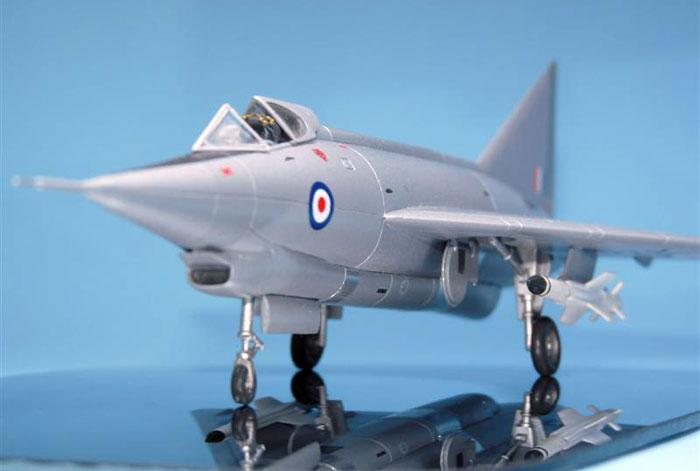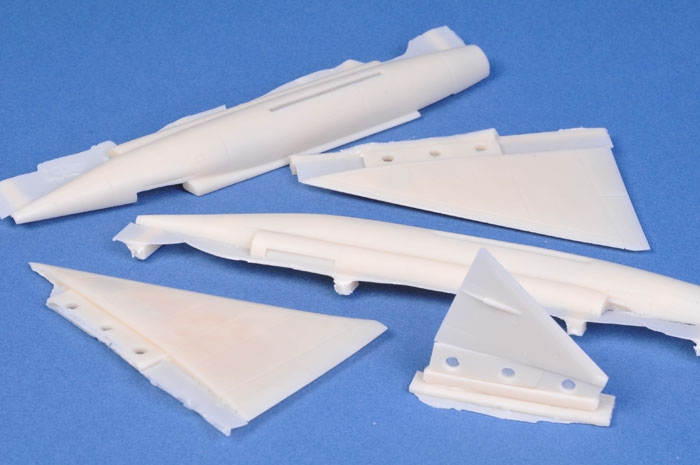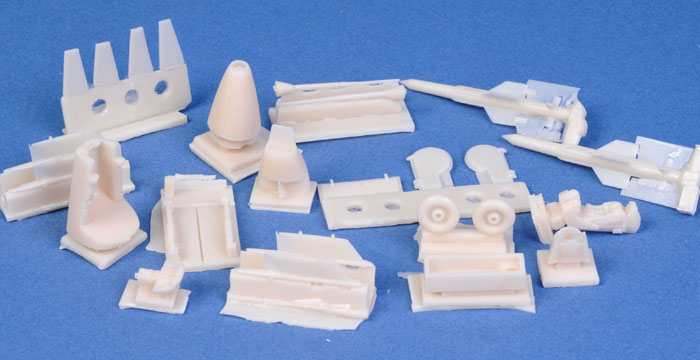Avro 720
Mixed Power Interceptor

Silver Cloud,
1/72 scale
S u m m a r y : |
Catalogue Number: |
Silver Cloud Kit Number SCK7201 - Avro 720 Mixed Power Interceptor |
Scale: |
1/72 |
Contents & Media |
30 x cream resin airframe parts, 2 x clear resin canopy & gun-sight parts, and 3 x white metal undercarriage legs. |
Price: |
Available online from Freightdog Models for £29.99 |
Review Type: |
First Look |
Advantages: |
Nicely cast, simple to build, white metal undercarriage. |
Disadvantages: |
No constructional diagrams (a minor inconvenience) |
Conclusions: |
Suitable as a first resin kit and highly recommended. |
Reviewed by Mark J. Davis

HyperScale is proudly sponsored by
Squadron.com
Following the end of WWII there was a thorough examination of German technology and concepts by the victors. The British in particular were quite taken with the idea of a rapid climbing rocket powered point defence interceptor as had been demonstrated by the Messerschmitt Me 163 Komet. The advantages of rocket power become more apparent the higher a plane flies, and the next generation of jet bombers was expected to be fast and high flying, making rocket power an attractive proposition.
The ability to climb to 60,0000 feet in 2.5 minutes was identified as an operational requirement in OR.301. Good maneuverability at high altitude was also required. In the first instance maximum operational speed was to be Mach 0.95 if this enabled substantial savings in design and development work, but ultimately the aircraft was to be capable of supersonic speed above 30,000 feet. The aircraft was to be armed with a battery of 2” air-to-air rockets and provision for the projected Bluejay air-to-air guided missile. The specification to meet this requirement, F.124, was sent in January 1952 to Avro, Blackburn, de Havilland, Fairey and, at their request, to Saunders Roe.
Avro soon realised that a that bomber targets could be expected to cruise at around Mach 0.9, and they determined that the best speed for an interception curve was Mach 1.25 to 1.5. Designing a supersonic aircraft from the start was obviously the way to proceed. Avro felt that a tail-less delta offered the best structural solution. Its sharp sweep with a thin wing offered strength with light weight, avoided the buffet problems recently found with tailed designs in the transonic region, and had a low wing loading for maneuverability. Of course by this stage Avro had a lot of delta knowledge with their work on the Avro 707 and Vulcan bomber.
Rather than have their rocket interceptors glide home as the Me 163 had, the British decided to add a small turbojet to enable the aircraft to return to base on modest power and land safely. A new specification F.137D was written to cover this change in the Avro 720. Main armament was to be two Bluejays carried under the wings, although two cannon or a rocket pack were to remain as alternative options.
In 1953 defence cuts announced that only one of the rocket/jet powered interceptors was to be developed. The RAF favoured the Avro with Bristol’s design second. The Saunders Roe SR 53 was in third place. However Treasury had approved funding for the SR.53 but stalled on the other two. So it was that the SR.53 flew whilst Avro had two 720 prototypes under construction (XD696 & XD701). The degree of progress made on these prototypes is unclear. Avro certainly built a mock-up that carried national markings and the serial number XD696, as a photo exists of this.
In the end the 1957 Defence White Paper with its myopic belief in missiles for air -defence killed off all manned fighter projects other then the EE Lightning which was sufficiently far progressed to just survive.
I have not seen a Silver Cloud kit previously, so it was with eager anticipation that I awaited its arrival after I was asked to review it. Silver Cloud is part of Freightdog Models, and I recalled reading with interest Hyperscale’s review the Freightdog Saunders Roe P.177R. Obviously this company has an interest in British “almost flew” and “what ifs”. This opens up to them a huge range of little known and interesting possibilities, most centered around cancelled 1950’s projects.
The P.177 review mentioned that Anigrand of Hong Kong produced the kit for Freightdog. I have some Anigrand kits and consider their standard to be generally similar to Magna Models’. So I was very pleasantly surprised upon opening the small, plain and sturdy top-opening box to find crisp and cleanly cast components to a much higher standard of finish than the Anigrand kits I have seen. On reading the instructions I noticed that A2Zee Models was credited at the bottom of the page with the casting, which must account for the quality of the components (along with the mastering done by Paul Lucas). The parts come in zip-lock plastic bags and are bubble-wrapped for additional protection.

A double-sided A-4 sheet provides a history of the aircraft, but there are no constructional diagrams. The instructions, such as they are, basically tell the modeller to wash the oil residue off the parts and to use CA glue rather than polystyrene cement. Mention is also made that some small production flaws can be expected with resin production techniques. A third of an A4 page is taken up by this advice. The reverse side has colour plan and profile views of the markings used on the mock-up in natural metal finish, and a Dark Sea Grey/Dark Green disruptive camouflage over High Speed Silver what-if scheme. The lack of instructional diagrams is probably related to the cost of graphic design, and a desire to achieve a certain price point for the kit. Whatever the reason, their absence is not a serious omission with this quite simple kit.
The resin parts follow a sensible and conventional parts breakdown as the photos illustrate. Their quality as I have indicated is very good, and is approaching that of the best Czech and Polish companies. It is to a similar standard of say Planet Models a few years ago, so it nice to see British limited run kit achieving such good quality levels. There will be a bit of cleaning up to do as is to be expected with resin, but nothing onerous. I also failed to find any pinholes worth mentioning.

The wings come with large tabs to mount inside slots on the fuselage, something that should prove useful, and is unusual for a resin kit where butt joins are the norm. The wings are commendably thin at their trailing edges, and the elevon actuator housings are nicely captured. The jet’s air intake and exhaust, and especially the rocket orifice, are quite a bit shallower than the resin medium is capable of achieving judging by leading European brands. I’d leave the small air intake as is and paint the back face black, but the two exhausts would benefit from being drilled out to a greater depth.
Assembly should generally prove easy despite the absence of constructional diagrams; as the location of parts is quite obvious, and the colour plans are sufficient for any confirmation of locations that is required.
Detail is good, with cockpit side-wall controls and equipment moulded within the fuselage halves. The ejector seat, an MB4 I think, is nicely done with all belt detail integral to the casting, needing only a firing handle to be added. The instrument panel is well done, but unfortunately will be hard to see in the small cockpit. Mind you don’t miss the control column, I nearly did. It’s on the same casting block as the two main undercarriage retraction jacks.
The one place where constructional instructions are needed is for the undercarriage. I missed it at first, but the instructions direct the modeller to a scrap view showing how the nose and main undercarriage legs are to be arranged, along with their doors. The undercarriage doors are nicely done, and the three undercarriage legs are cast in white metal to provide strength. These have some flash but should clean up well enough. The resin retraction linkages will then need to be attached between the wheel well and metal leg.

Two Firestreak missiles are provided along with under-wing pylons and launch rails (I got four pylons for some reason). These are a nice representation of the missile, with thinner fins than would be the case with injected styrene.
The cockpit canopy is moulded in clear resin, as is the gun-sight. The thin canopy is already clear enough to see the seat detail through, but a light polish and dip in Future will enhance this aspect of the model. The Avro 720’s windscreen was of a similar style to that used on the Convair F-102 and F-106 (amongst others), consisting of two flat triangular panels forming a sharp ridge along their centreline. I do not know if the 720 had a vision splitter plate between this centreline and the cockpit coaming above the instrument panel like these other aircraft did. If so, the kit does not provide one.

Two nose probes are provided; both are the same, so presumably one is a spare in case you have trouble removing it from the casting block.
Decals appear to have good opacity and the registration is good. They cover the markings applied to the mockup, which would also have applied to the first prototype. The what-if markings intended for use with the grey/green camouflage scheme include a choice of coloured squadron bars to flank the fuselage roundel (they look familiar to ones I’ve seen on other British fighters).

There are a couple of squadron symbols on white circles consisting of a cockerel or a red-winged sword, plus a tigers head which I’m sure I have seen on some EE Lightnings. I’m sure they’re from authentic 1960’s fighter squadrons as the markings guide has notes for each. But without my optivisor I could not read the tiny print explaining which squadrons are represented, as the print is the size of aircraft stenciling for a 1/144 scale model!
This is a very well executed kit of an attractive and interesting subject. This one really would be an interesting and tempting model, especially if completed in a what if service scheme. Its almost flew status takes it beyond being simply an on-paper what-if, but will still appeal to a fairly limited market. Despite this, it would make a nice partner to the SR.53 previously kited by Airfix many years ago (a good future subject for Silver Cloud perhaps?) and Freightdog’s P.177R.
Suitable as a first resin kit and highly recommended for any fans of British post-war project aircraft.
Thanks to Silver Cloud and Freightdog Models for the review sample
Silver Cloud kits and decals are available online from their website at
http://www.freightdogmodels.co.uk
Text and Images Copyright © 2009 by Mark J. Davis
Page Created 19 March, 2009
Last updated
19 March, 2009
Back to HyperScale Main Page |
